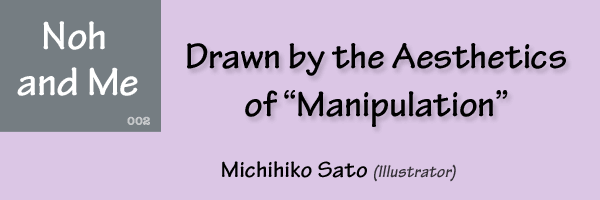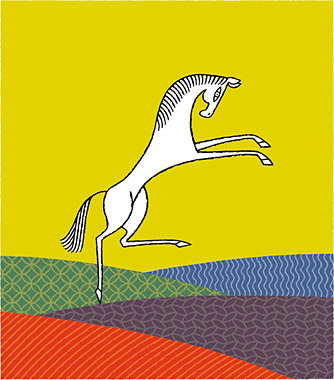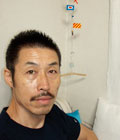 |
 |
 |
| | Home | Essay : Noh and Me | Michihiko Sato |
| |
|
|
There are those who were involved with Noh from a very young age.
There are those who were attracted to Noh as adults. There are all sorts of relations with Noh.
We will be speaking with a variety of people from various walks of life about their experiences
with and relation to Noh, its attraction for them and its charms.

 |
Illustration: Takeuma |
In this busy age, at those times when I suddenly lose sight of myself, I open the glass doors of my bookcase and take out an old worn book, opening it to the first page. And with that, there, I slowly recall myself and my reasons for living and with them the power to press on.
That old worn book was published by Heibonsha in 1978, the Taiyo special edition No. 25 – Noh. Inside, written by a director by the name of Tadashi Suzuki, is an article entitled “The Violence of the Brake.” Printed alongside the article is a small photograph I enjoy looking at taken at the Waseda Shō Gekijō.
In the photograph dressed in white is Kayoko Shiraishi. She has a wound on her forehead and shakily balances on half a tatami mat, her long black hair hanging down. Next to her is a man holding a Japanese sword as he appears to unsuccessfully try to strike a fighting stance.

The “violence of the brake” is a good expression, I think.
They were the words uttered by Polish theater director Jerzy Grotowski when, on a trip to Japan and at the guidance of Tadashi Suzuki, he watched Kanze Hisao going through his training practice. “Along with and despite the physical and physiological hardship and restrictions, it’s as if there is a violent tearing of the air. And yet, it is done at a standstill.” This aspect is what Grotowski means when he refers to “the violence of the brake.”
Of course, I’m not saying that I realized that early on. It wasn’t until I’d read the article “Dromos/Speed Revolution” by Paul Virilio. According to that article, crossed “above the Pharaoh’s death mask were a whip and a hooked pole, or bit. The whip was to increase the pace of the forward movement and the hook acted as a brake on the horses pulling the army wagons. This portrayed the nature of government to regulate and control speed”…. When I read this I was reminded of “the violence of the brake” and learned the aesthetic nature of “manipulation” in “the science of speed.”
Even if one gives examples of all sorts of things that are at a standstill, speed or movement is still inherent. For an example close at hand, I was once again reminded of Noh. If you watch a Noh performance with this in mind, you will come to vividly perceive things that you couldn’t perceive before.

Figuring largely in my coming to know the thrill of Noh was the presence of the ōtsuzumi, or large drum player Shonosuke Okura. He would strike an authoritative pose and with bare hands (normally the fingers are wrapped in leather) playing the drum he would cry out with calls of “Iyoooo Roroorororo!!, Gaaan!!”
Keeping to the area just by the curtain, just in your peripheral vision, he would, while he looked to not be looking at all, bring the tension up in preparation for the entrance of the shite, or primary actor. Like a conductor, he would fill every bit of space with energy. His right hand stretched out horizontally, beating its bare rhythm, picking up speed like the legs of a predator racing across the field. I had yet to see such blatant talent in an ōtsuzumi player before him.
I can still remember it now, every pore in me wide open, goose bumps over my entire body. When this violent brake and an open throttle are in balance, permeating every inch of the entire Noh theater, we, the audience, are as if under the sway of a hypnotist, easily lulled into whatever illusory heaven or hell we may be invited to enter.
Yet, achieving this effect is something that should be attempted only on rare occasion. One superb performer can destroy the balance on the stage. But, I have the feeling I have been in that moment before, where I have seen the illusions.

One of the performances that have left with me with a deep impression despite the passage of time is “Izutsu,” or The Well Head as performed with Akio Kanze, or Tetsunojō IX as the shite. With but the slightest of movements by the shite, even the white crests worn by the jiutai-za appear to shine like moonlight. One comes to see what is not there, the watery reflection of the moon in the water of the well.
Also, the movements of Tetsunojō VIII in “Tomonaga” were so good as to be almost scary. It was if one were looking at a film being played forward frame by frame. Each moment, intense and coming on top of one another, with their afterimages remaining, their vibrations mingling with individual illusions…I can still remember it so clearly.
Even though the stage is said to be for harmony above all else, it simply wouldn’t do to present anything less than sharp, clear images. Even though attempting to achieve excellence may endanger the harmony on stage, I, for one, will be there looking for it.
(July 2008)
 |
Michihiko Sato Born in Mie Prefecture in 1947. Awarded the Asahi Advertising Award for Best Expression. Recipient of the 8th Warsaw International Biennale’s Special Award. Author of the poetry and picture collection “White Wine, Black Wine” and calligraphy and picture collection “Santōka-san,” among others. His epic poem “Transylvanight” is published on his blog. Web site: http://www.michihico.com |
| Terms of Use | Contact Us | Link to us |
Copyright©
2026
the-NOH.com All right reserved.